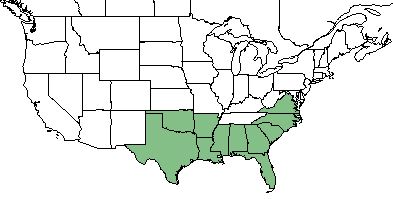Difference between revisions of "Smilax smallii"
(→Cultivation and restoration) |
|||
| Line 23: | Line 23: | ||
==Description== <!-- Basic life history facts such as annual/perrenial, monoecious/dioecious, root morphology, seed type, etc. --> | ==Description== <!-- Basic life history facts such as annual/perrenial, monoecious/dioecious, root morphology, seed type, etc. --> | ||
| − | ''Smilax smallii'' is a monoecious perennial that grows as a shrub or vine.<ref name="USDA"/> Leaves are small, light-green, shiny, and evergreen. Flowers are small, yellowish, and in clusters. Berries will remain a dull, brick red color for long periods of time before turning a dark reddish brown at maturity. Stems typically lack spines and occur at right angles to the main stem. This plant can reach lengths of 6-12 ft (1.83-3.66 m).<ref name="Ladybird"/> | + | ''Smilax smallii'' is a monoecious perennial that grows as a shrub or vine.<ref name="USDA"/> Leaves are small, light-green, shiny, and evergreen. Flowers are small, yellowish, and in clusters. Berries will remain a dull, brick red color for long periods of time before turning a dark reddish brown at maturity.<ref name="Ladybird"/> Pedicels are unequal and range from 1-4 in (2.5-10.2 cm).<ref name="Morong 1894">Morong T (1894) The Smilaceae of North and Central America. Bulletin of the Torrey Botanical Club 21(10):419-443.</ref> Stems typically lack spines and occur at right angles to the main stem.<ref name="Ladybird"/> This plant can reach lengths of 6-12 ft (1.83-3.66 m).<ref name="Ladybird"/><ref name="Morong 1894"/> |
==Distribution== | ==Distribution== | ||
Revision as of 13:25, 22 January 2018
| Smilax smallii | |
|---|---|

| |
| Photo by John Gwaltney hosted at Southeastern Flora.com | |
| Scientific classification | |
| Kingdom: | Plantae |
| Division: | Magnoliophyta - Flowering plants |
| Class: | Liliopsida - Moncots |
| Order: | Liliales |
| Family: | Smilacaceae |
| Genus: | Smilax |
| Species: | S. smalliis |
| Binomial name | |
| Smilax smallii Morong | |

| |
| Natural range of Smilax smallii from USDA NRCS [1]. | |
Common Name(s): Jackson-briar;[1] lanceleaf greenbrier;[2] southern smilax; jacksonvine[3]
Contents
Taxonomic Notes
Synonym(s): S. maritima;[1] S. domingensis; S. lanceolata[2]
Description
Smilax smallii is a monoecious perennial that grows as a shrub or vine.[2] Leaves are small, light-green, shiny, and evergreen. Flowers are small, yellowish, and in clusters. Berries will remain a dull, brick red color for long periods of time before turning a dark reddish brown at maturity.[3] Pedicels are unequal and range from 1-4 in (2.5-10.2 cm).[4] Stems typically lack spines and occur at right angles to the main stem.[3] This plant can reach lengths of 6-12 ft (1.83-3.66 m).[3][4]
Distribution
This species primarily occurs on the coastal plain from Virginia, south to central peninsular Florida, westward to Texas.[1][2] It can also be found in Puerto Rico.[2]
Ecology
Habitat
S. smallii is found in bottomland forests.[1] It prefers moist alluvial acidic soils[3] and is drought tolerant.[5]
Phenology
Flowering occurs from May through July[1][6] and fruits from April to June of the following year.[1] A study in Florida, reported flowering in June and fruiting from February through July.[7]
Use by animals
S. smallii comprises 5-10% of the diets of large mammals, small mammals, and terrestrial birds.[8] Larger mammals can include deer and cattle.[9] Humans have also utilized this species in decorations, landscaping, and as a source of food, consuming tubers and new spring growth.[5]
Conservation and Management
S. smallii is sometimes used in landscaping projects. However, since the species is not widely cultured, some contractors will collect samples locally. This has the potential to negatively impact populations if the species popularity continues to increase, especially in times of drought, pest outbreaks, or disease outbreaks where native species are more apt to prosper.[5]
Cultivation and restoration
Propagation can occur via root divisions, seeds, semi-hardwood cuttings, and softwood cuttings.[3] However, more research on propagation techniques are needed.[5]
Photo Gallery
References and notes
- ↑ 1.0 1.1 1.2 1.3 1.4 1.5 Weakley AS (2015) Flora of the Southern and Mid-Atlantic States. Chapel Hill, NC: University of North Carolina Herbarium.
- ↑ 2.0 2.1 2.2 2.3 2.4 USDA NRCS (2016) The PLANTS Database (http://plants.usda.gov, 22 January 2018). National Plant Data Team, Greensboro, NC 27401-4901 USA.
- ↑ 3.0 3.1 3.2 3.3 3.4 3.5 Plant database: Smilax smallii. (22 January 2018) Lady Bird Johnson Wildflower Center. URL: https://www.wildflower.org/plants/result.php?id_plant=SMSM
- ↑ 4.0 4.1 Morong T (1894) The Smilaceae of North and Central America. Bulletin of the Torrey Botanical Club 21(10):419-443.
- ↑ 5.0 5.1 5.2 5.3 Davis BE, Chappell MR, Schwevens JD (2012) Using native plants in traditional design contexts: Smilax smallii provides an example. 13(1):27-34.
- ↑ Nelson G (22 January 2018) PanFlora. Retrieved from gilnelson.com/PanFlora/
- ↑ Skeate ST (1987) Interactions between birds and fruits in a northern Florida hammock community. Ecology 68(2):297-309.
- ↑ Miller JH, Miller KV (1999) Forest plants of the southeast and their wildlife uses. Southern Weed Science Society.
- ↑ Thill RE (1984) Deer and cattle diets on Louisiana pine-hardwood sites. The Journal of Wildlife Management 48(3):788-798.